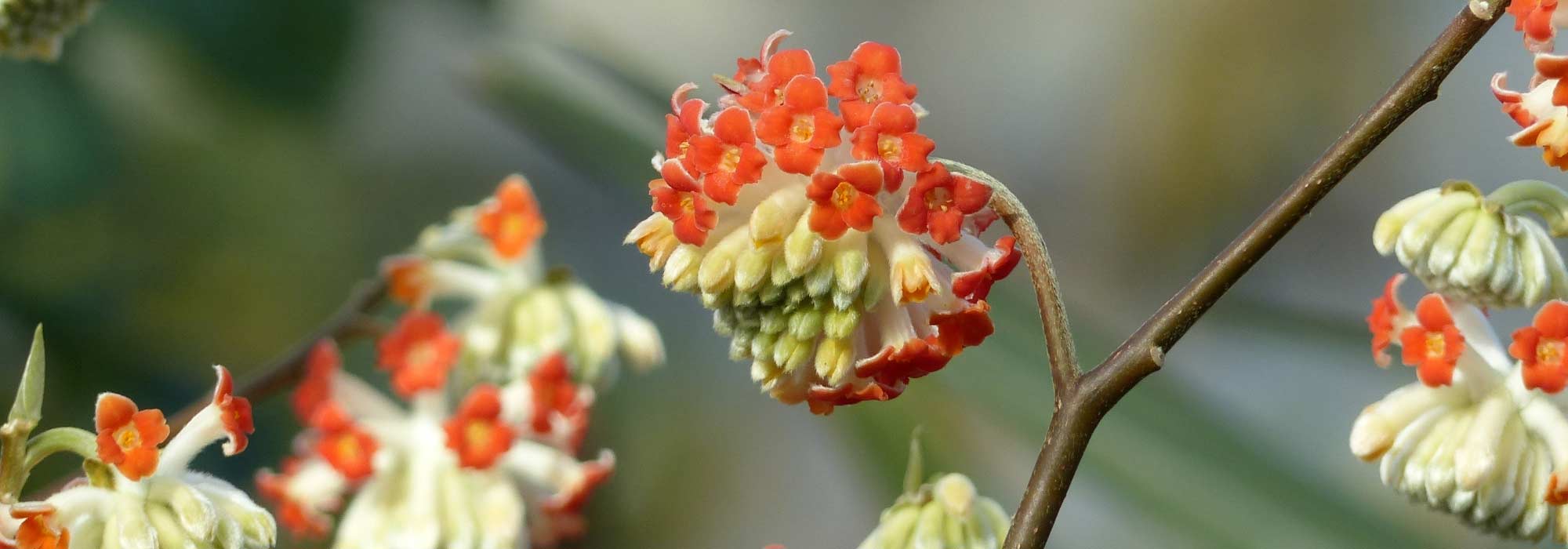
Edgeworthia chrysantha, paperbush: planting and care
Contents
Edgeworthia in a nutshell
- Small shrub (1.50 m tall), moderately hardy, easy to grow in temperate regions south of the Loire
- With an original silhouette and an exotic, luminous flowering that dots the naked wood
- At the end of winter, it is adorned with gold, white or orange-red flowers with an intoxicating scent that set the still-sleeping garden ablaze
- It thrives in light, acidic and well-drained soil
- With slow growth, this singular, compact bush is well suited to small gardens, urban gardens and grows very well in pots
A word from our expert
Edgeworthia chrysantha (syn. E. papyrifera) or paperbush, is a early-flowering shrub of fabulous quality still unfairly little known. At first signs of spring, its silky pom-poms of flowers, golden-yellow, white or vermilion, intensely scented, awaken garden still asleep from cold and create an extraordinary picture.
Les fleurs de l’Edgeworthia grandiflora, de l’Edgeworthia chrysantha ‘Red Dragon’ ou encore de l’ Edgeworthia ‘Akabana’ sont remarquables lorsqu’elles apparaissent sur les rameaux encore dénudés.
With relative hardiness (-10°C to -15°C), Edgeworthia chrysantha is more accommodating south of the Loire and in an oceanic climate where it will thrive in light shade and in fresh, acidic and fertile soil. Once well established in conditions that suit it, Edgeworthia chrysantha requires little maintenance.
Its original silhouette creates lovely focal points in borders, or, in a pot on a terrace, to make the most of its scent. Discover this genuine bush for collections that brings, as winter ends, a unique, exotic touch, heralding spring to come.
Description and botany
Botanical data
- Latin name Edgeworthia
- Family Thymelaeaceae
- Common name Paperbush, paper bush, yellow-flowered Edgeworthia
- Flowering February to April
- Height 1 to 2 m
- Sun exposure Sun, partial shade
- Soil type Neutral, acid, well-drained
- Hardiness -10°C to -15°C
Edgeworthia or “paper bush” is a small bush native to China and the Himalayas, belonging to the family Thymelaeaceae, like its relative Daphne. The genus Edgeworthia contains only three species growing wild in woods or on shrubby mountain slopes.
Edgeworthia chrysantha, or “gold-flowered edgeworthia”, is the only species cultivated in gardens. Clothed with white and golden flowers in the species type, it has produced some interesting cultivars such as ‘Red Dragon Akebono’ and ‘Akabana’ with orange-red flowers and the recent ‘Nanjing Gold’. Edgeworthia chrysantha var. grandiflora is a fine variety with flowers even larger than those of the species type.
Of rather slow growth, Edgeworthia is a low, unobtrusive bush that spreads progressively to reach on average 1 to 2 m in height and width at maturity. It has a pretty, spreading bushy habit as wide as tall and very ramified from the base. Its very short trunk characteristically divides into three secondary branches. Over time it disappears under the many peripheral twigs, eventually forming a compact bush. This wide ramure bears thick, vigorous yet flexible branches with a
Edgeworthia is prized for its fabulous winter flowering which dots the tips of the bare twigs much like Hamamelis or Forsythia. From mid-January, sometimes earlier or in March depending on region, flower buds enclosed in delicate silvery bracts appear.
Then, for about a month, before the leaves, downy tubular flowers with four spreading lobes open at the tips of the bare twigs in globular, semi-pendent umbels 4–5 cm in diameter, each bearing some 30 to 50 flowers. Their calyx is densely covered with white, silky hairs on the outside and encloses short yellow stamens.
Golden-yellow, white or orange-red, these silky, scented half-pompoms open from centre to edge, fading to white at the periphery so that the inflorescence is bicoloured. Although fairly small (5 mm), their profusion and the <strongheady, spicy, floral perfume evoking both <strongjasmine, clove and honeysuckle which can be perceived up to 5 m away, warm the winter. Non-edible fruits, small drupes with a stone, develop in summer following the flowers on the twigs. Twigs already in flower but still bare are much prized in Ikebana floral art.
The deciduous foliage is another asset of Edgeworthia; lush and exotic, it follows flowering and, although it can last all summer, tends to drop during hot spells. It will fall in autumn. Large alternate, entire, ovate to lanceolate leaves appear after flowering at the top of the stems. Reaching up to 15–20 cm long, they are borne on short petioles, coriaceous, glossy above and slightly velvety beneath. Pale green to dark green or bluish-green, they show well-marked, paler parallel veins.
More demanding than a Sarcococca but much less so than a Rhododendron, the “paper bush” is not difficult to grow… provided its needs are met. With fairly low hardiness, around -10 to -15°C in sheltered situations, it is easier to cultivate where winters are relatively mild, planted away from spring frosts and cold, drying winds.
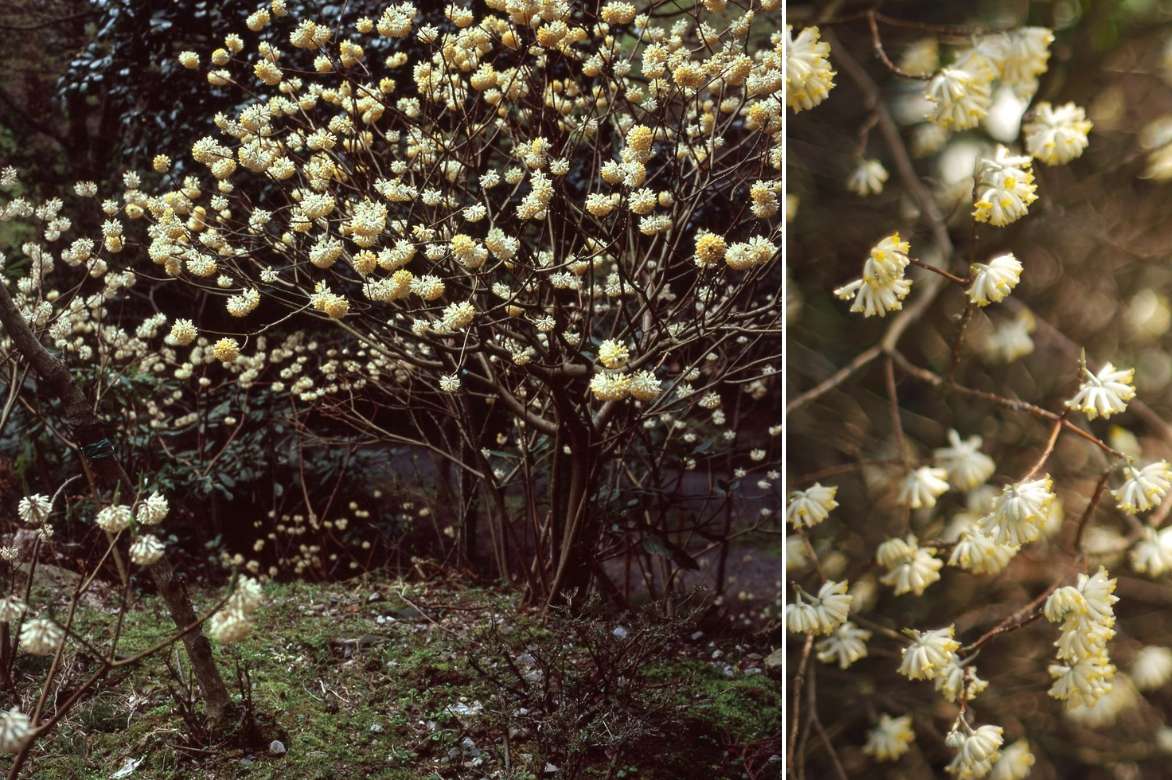
Edgeworthia chrysantha (left photo Nishimoto-Flickr, right photo Kentama-Flickr)
In other regions, it can be grown in a pot and brought into a conservatory at the first frosts like citrus plants. Its aversion to heat must also be respected and it should be spared Mediterranean climates, which are a little too hot and dry in summer. It can therefore only be grown reliably in the open ground in mild, humid climates such as the Atlantic coast.
It dislikes scorching sun and prefers partial shade. It is satisfied by all types of <strongnon-calcareous, light, acidic, cool and well-drained soils. This bush will find its place naturally in the garden alongside Daphne, Camellia, Pieris and Kalmia.
It can be used in borders, as a specimen or in a pot. Its singular silhouette needs its own space and is ideally planted as a specimen in a well-open area, visible from the house. It will form an attractive focal point in a border. Its slow growth allows .
Also called “Mitsumata”, Edgeworthia chrysantha has been naturalised in Asia where it is intensively cultivated for making a luxury paper from its stems, the washi. This very strong Japanese paper is used for calligraphy, watercolours or banknotes.
Read also
How to prune early flowering bushesMain species and varieties
Edgeworthia chrysantha (syn. E. papyrifera) est the only species cultivated in our gardens. If the type species bears golden flowers, it has given rise to some cultivars with striking colours. Edgeworthia grandiflora is another variety offering flowers even larger than those of the type species.
Most popular
Our favourite varieties
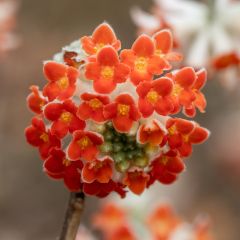
Edgeworthia chrysantha Red Dragon Akebono - Paperbush
- Flowering time March to May
- Height at maturity 1,20 m
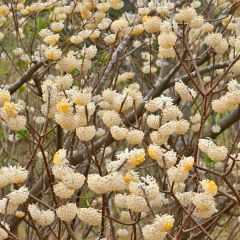
Edgeworthia chrysantha Grandiflora - Paperbush
- Flowering time March to May
- Height at maturity 1,50 m
Discover other Edgeworthia
View all →Available in 0 sizes
Available in 1 sizes
Available in 1 sizes
Available in 1 sizes
Available in 1 sizes
Available in 1 sizes
Planting
Where to plant the paperbush or Edgworthia chrysantha?
Although it can withstand temperatures around -10 °C, Edgeworthia will be easier to grow in mild climates such as Brittany. As it dislikes excessive heat as much as strong sun, avoid planting it in a Mediterranean climate that is too hot and dry in summer.
Preferably place it in a lightly shaded spot against a south- or west-facing wall, sheltered from cold winds that could dry it out and damage the earliest flowers, which are particularly sensitive to late frosts.
Grow it in a spot that is sunny in the morning but sheltered from direct afternoon sun: it still needs maximum light in winter to flower abundantly.
North of the Loire, opt for container culture, overwintering from first frosts in a conservatory in the manner of orange-house plants.
Admittedly it has some requirements, but it is not difficult to grow in light, rather acidic heather soil that is well drained. It will thrive in deep, humus-bearing soil that is neither too dry nor too wet. Like rhododendrons and Daphnes, it does not tolerate presence of lime in soil. Paper bush takes time to establish and tolerates transplantation very poorly: choose a permanent location.
Slow-growing, paper bush is a compact bush, well suited to small gardens or town gardens.
Its harmonious, slightly exotic habit should not be hidden: ideally plant as a specimen in centre of a border against a background of evergreen foliage or in a well cleared spot, visible from the house — it perfumes up to a radius of 5 m! You can also plant in groups of 3 or 5 under large deciduous trees or in a low hedge.
In a pot, in regions with harsh winters, you can also enjoy its magnificent colours and fragrance on a terrace or near entrances.
When to plant the paper bush or Edgworthia?
Planting Edgworthia is preferably done after flowering, in September–October, or in spring in April–May.
How to plant the paper bush or Edgworthia?
In open ground
- Soak rootball
- Dig a wide hole 30 cm deep and at least 80 cm wide
- Add heather soil or turf to garden soil if it is calcareous
- If necessary, add gravel to bottom of hole to ensure good drainage
- Plant bush with collar at soil level
- Water copiously then regularly during first two years to ensure establishment
- Mulch with dry leaves or plant small perennials to protect base and reduce watering: it likes its roots kept cool during summer
In a pot
Edgeworthia chrysantha is magnificent in a pot. Choose a large container from the start, because it is a sensitive plant that hardly tolerates repotting. Provide a rich, fresh, very free-draining soil-based mix.
- Plant on a draining layer (sand, clay pebbles) in a mix of loam, potting compost or heather soil
- Water once or twice a week, taking care to allow surface to dry between waterings
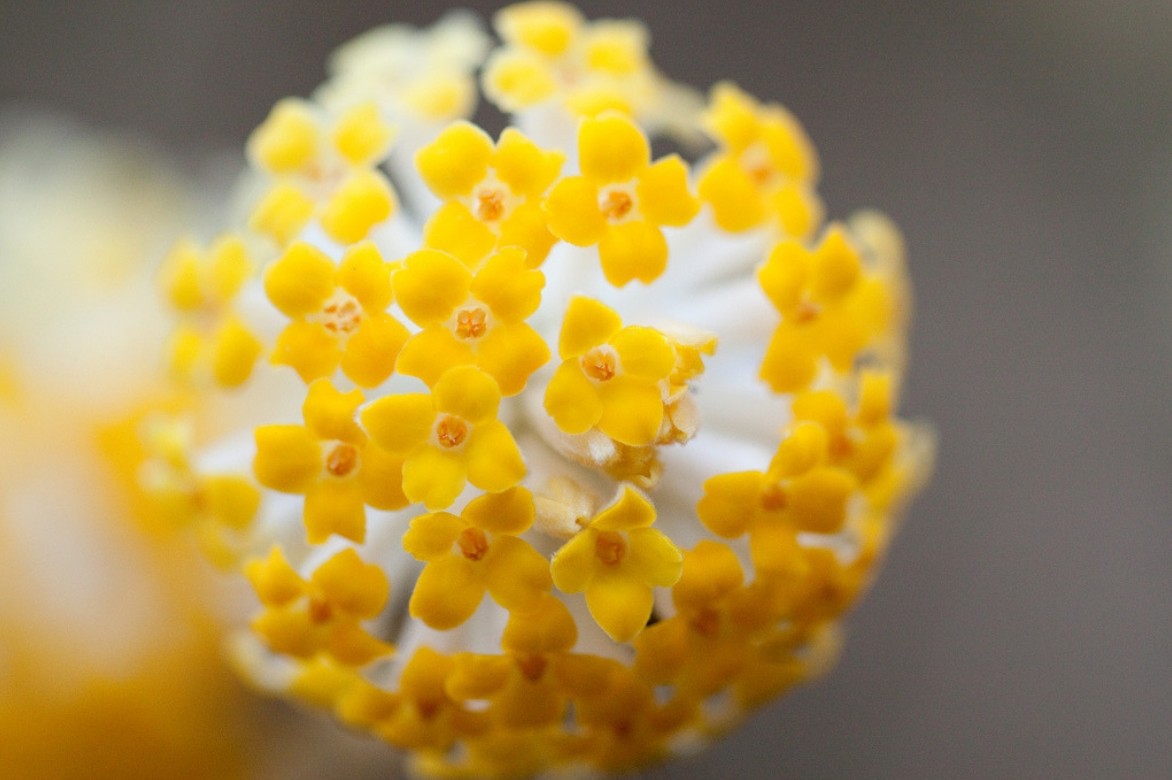
Paper bush (photo nekonomania)
Read also
Plant young ericaceous plantsMaintenance, pruning and care
Once well established, Paperbush requires little care.
Water regularly once or twice a week especially during first two years and in periods of prolonged drought.
Cover with a good organic mulch (dry leaves, hemp…) to keep its roots cool during summer heat.
In spring or autumn, apply compost by light surface fork-over at its base.
In a pot, water once or twice a week and apply a liquid fertiliser every month between March and August. Water sparingly in winter.
When and how to prune an edgeworthia?
Pruning is not necessary for this slow-growing bush, which naturally has an attractive habit. Only prune after flowering from August to December to remove any dead or poorly placed shoots and to slightly reduce its size. If you must transplant: cut back to encourage regrowth.
L’Edgworthia chrysantha has no known enemies. It is unaffected by most diseases and by attacks from insects or parasitic organisms. If foliage yellows, add heather soil as sign that soil is probably too calcareous for this acidophilous bush.
Propagating Edgworthia
As the paperbush fruits, you can try sowing, but it is a long, tricky operation that we do not recommend. Instead opt for separating suckers or propagation by cuttings.
Division
- In autumn or winter, lift basal suckers that have roots
- Cut back by about one third
- Replant immediately in a pot filled with potting compost
- Keep sheltered from frost in a cool place
- Plant out in garden in spring
When and how to take cuttings of paperbush?
- After flowering, in August–September, take semi-woody or semi-ripe shoots 15–20 cm long (i.e. stems transitioning from soft to woody)
- Remove leaves from lower part of shoots, leaving only two
- Plant them in a humus-bearing, light and well-draining substrate and cover with plastic
- Keep moist
- Pot them into buckets as soon as they have formed roots
- Overwinter them frost-free in a bright, cool place
- Plant out in open ground the following spring
Associating
Still too little known, the Edgeworthia or Paperbush deserves a place of honour in winter scenes alongside Hamamelis. With its very graphic silhouette and fragrant, brightly coloured flowering, it brings an exotic touch to garden still bare and numbed by cold.
Dress its base with a carpet of winter heathers, Heucheras and Hellebores or early bulbs such as winter aconites, daffodils, crocuses, lungworts, erythroniums, primroses or tulips to accompany it into spring.
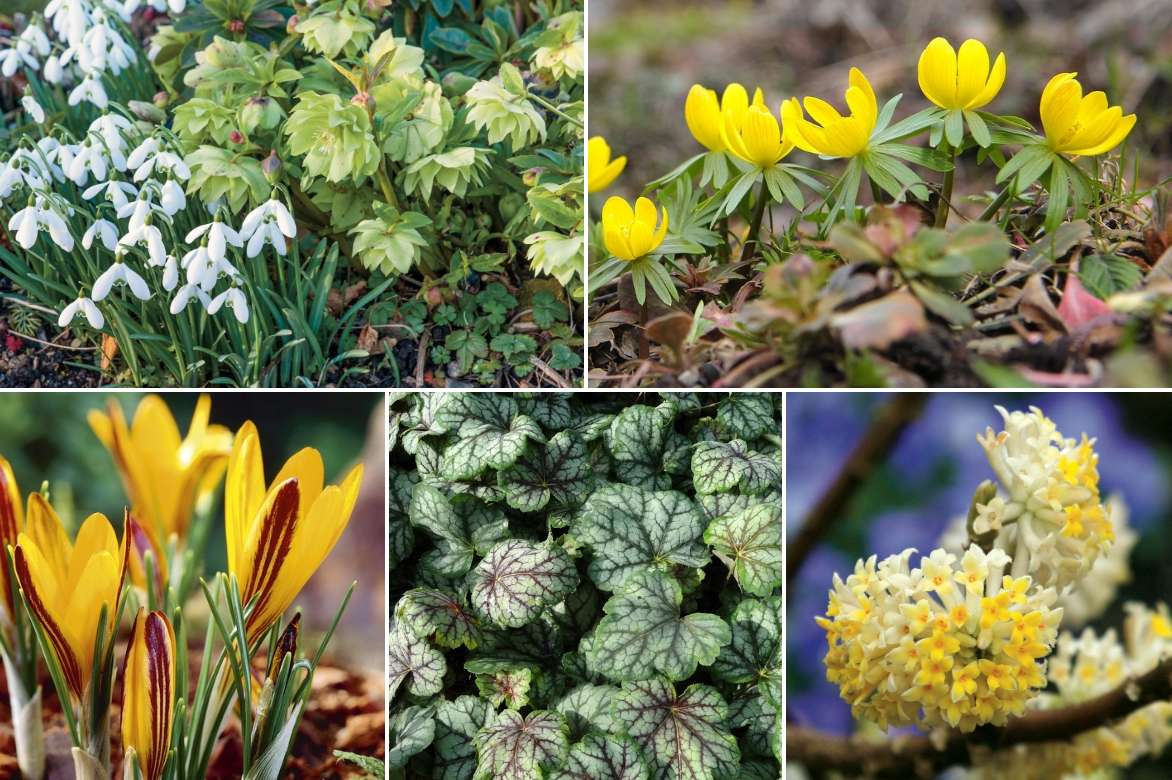
An idea for a planting combination: Galanthus nivalis, Helleborus orientalis, Eranthis cilicica, Crocus angustifolius, Heuchera ‘Green Spice’, Edgeworthia chrysantha
Its golden, white or orange flowers will contrast beautifully with blue of Muscari, hyacinths, Ipheions, Scillas…
Its delicate flowers are best set off by a permanent green backdrop made up of conifers, bushes with evergreen foliage or grasses such as pennisetum.
Magnificent in early spring, after flowering this bush will assume a rather ordinary appearance; its summer foliage limits light at its base, so choose some shade-loving perennials, such as ferns, Omphalodes, Japanese anemones, bleeding hearts or foxgloves to surround it.
In a small flowering hedge, it can be paired with winter-flowering bushes such as Hamamelis, which will precede it, or spring-flowering ones such as Forsythia, which will take over the flowering.

An example of a spring hedge combination: Hamamelis ‘Jelena’, Edgeworthia chrysantha ‘Red Dragon’ and Forsythia intermedia
Edgeworthia, preferring acidic soils, can be easily paired with ericaceous plants with evergreen foliage and winter flowering such as Camellia, Pieris, Kalmia, Skimmia, Sarcococca, rhododendrons and azaleas from Japan or other Daphnes.
For a colourful winter garden, plant it near one or more ornamental fruit bushes such as ornamental apple, or some Cornus with coloured wood.
In a large pot, it can be paired with a Holly or a Euonymus and with small spring-flowering bulbs.
→ Discover other ideas for pairing with Edgeworthia chrysantha in our advice sheet
Useful resources
- Magnificent flowering, captivating fragrance, discover Edgeworthia chrysantha
- Discover 6 ideas for pairing Edgeworthia
- To successfully grow Paperbush, also consult our article “planting bushes in heather soil“
- How to liven up your garden in the dull season?
- Early-blooming bulbs herald spring, which ones will dress the base of your Paperbush?
Frequently asked questions
-
Why are the leaves of my paper bush turning yellow?
This bush needs fairly acidic soil to thrive. It may well be suffering from chlorosis, a sign that soil is too calcareous for it; better to move it and replant it in soil enriched with heather soil… if it is still possible, because it hates transplanting.
- Subscribe!
- Contents
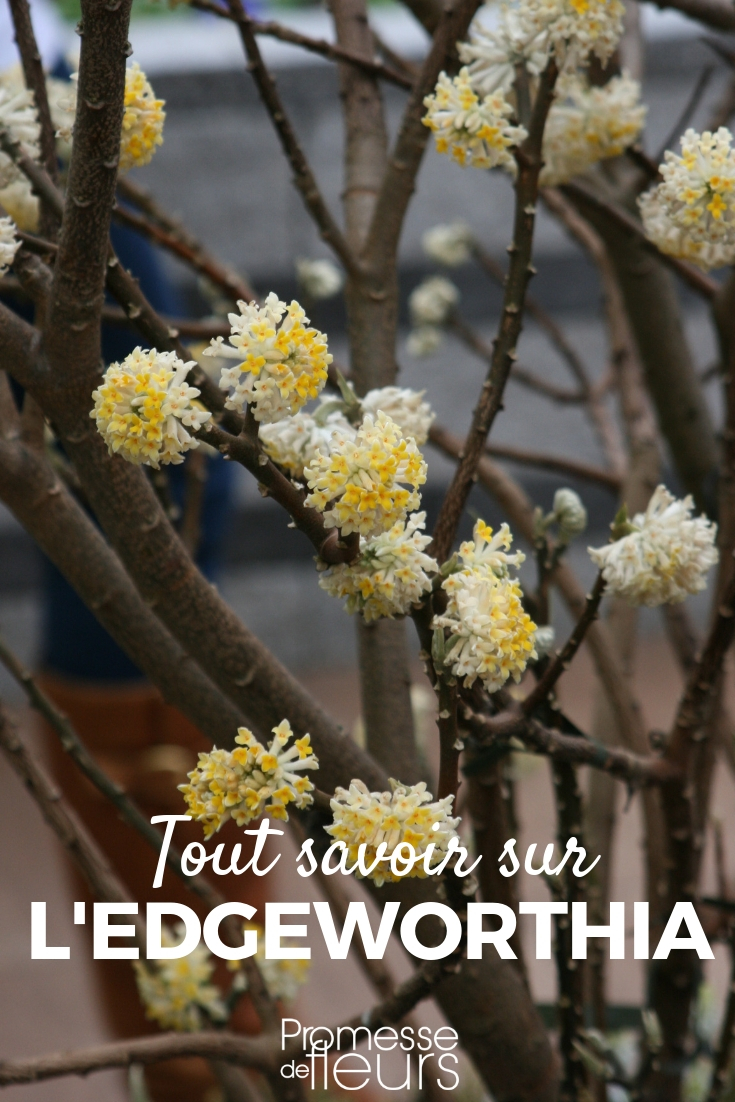































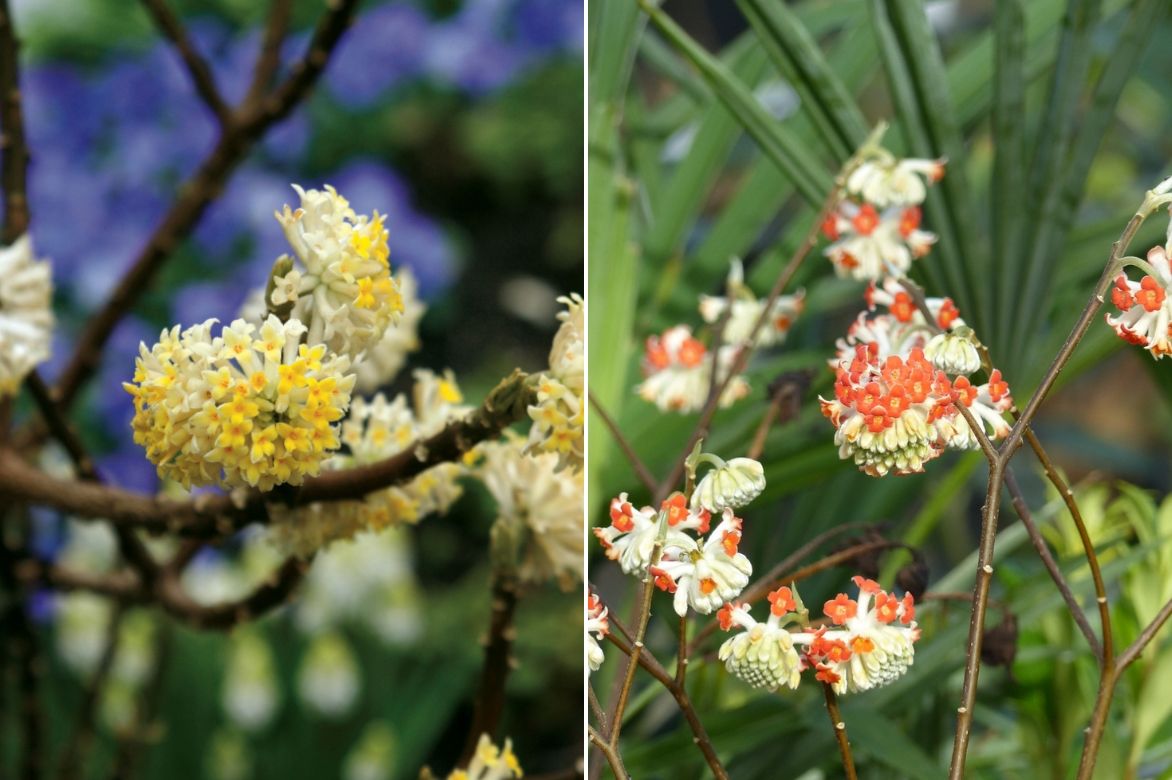
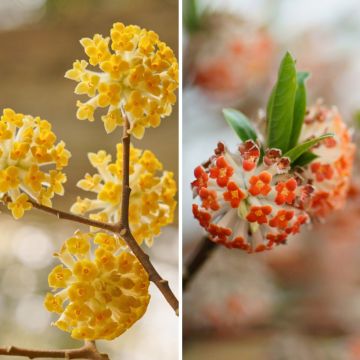


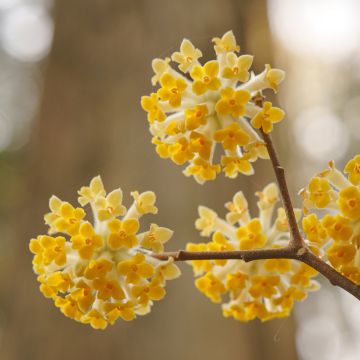
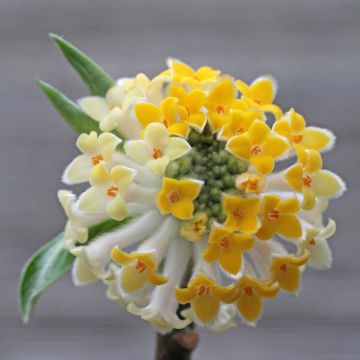
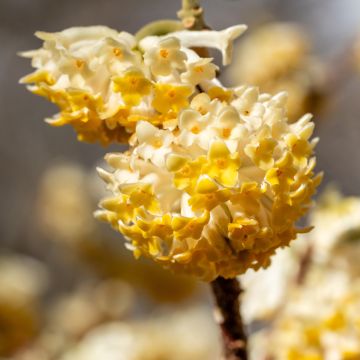
Comments